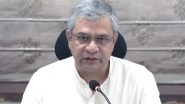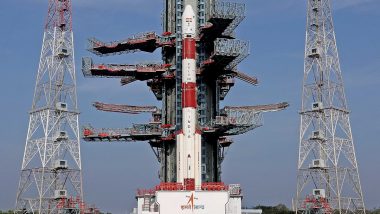Chennai, December 17: The Indian space agency is gearing up for the year's last space mission, orbiting communication satellite CMS-01 (formerly GSAT-12R) on Thursday at 3.41 p.m. with its rocket PSLV-C50. According to Indian Space Research Organisation (ISRO), the filling of fuel and oxidizer for the second stage of the rocket has been completed. The countdown for the launch is progressing smoothly at the Sriharikota rocket port in Andhra Pradesh.
The 44-metre-high four staged/engine PSLV-C50 is the 22nd flight of PSLV in 'XL' configuration (with six strap-on motors hugging the first stage). The PSLV in normal configuration is a four stage/engine expendable rocket powered by solid and liquid fuels alternatively with six booster motors strapped on to the first stage to give higher thrust during the initial flight moments. ISRO to Launch Communication Satellite CMS-01 Onboard PSVL-C50 from Satish Dhawan Space Centre on December 17.
ISRO's Tweet
Filling of fuel and oxidizer for the second stage(PS2) of #PSLVC50 completed.#CMS01
Updates will continue...
— ISRO (@isro) December 17, 2020
The Indian space agency has PSLV variants with two and four strap-on motors, larger PSLV-XL and the Core Alone variant without any strap-on motors. The choice of the rocket to be used for a mission depends on the weight of the satellite and the orbit where the satellite it is to be orbited.
According to ISRO, the PSLV-C50 rocket carrying CMS-01 is tentatively scheduled to blast off at 3.41 p.m. from the second launch pad at the rocket port in Sriharikota, in Andhra Pradesh. The launch is subject to weather conditions, the ISRO had earlier said.
CMS-01 is a communication satellite envisaged for providing services in Extended-C Band of the frequency spectrum, which will include the Indian mainland, Andaman and Nicobar and Lakshadweep Islands. The 42nd communication satellite of India, it will have a mission life of seven years.
About 20 minutes into its flight, PSLV-C50 will eject CMS-01 into geosynchronous transfer orbit (GTO) and from there, the satellite will be taken up and positioned at geosynchronous stationary orbit. The CMS-01 will be a replacement for GSAT-12 that weighed 1,410 kg and was launched on July 11, 2011 with a mission life of eight years.
ISRO Chairman K. Sivan had earlier said the PSLV-C50 rocket will be followed by the launch of new small rocket Small Satellite Launch Vehicle (SSLV) carrying EOS-02 (Earth Observation Satellite), and Geosynchronous Satellite Launch Vehicle-F10 (GSLV) carrying EOS-3.
The other Indian satellites that are ready for launch are GISAT and Microsat-2A. The launch of the GISAT-1 satellite slated for March 5 this year was postponed due to technical reasons a day before the launch.
The GISAT-1 satellite will be carried by a GSLV rocket. The GSLV rocket was dismantled after the launch was called off, and is being refurbished. The rocket's cryogenic engine has been brought down and it is being readied again. The GSLV carrying GISAT-1 is expected to fly after PSLV C50.
(The above story first appeared on LatestLY on Dec 17, 2020 11:01 AM IST. For more news and updates on politics, world, sports, entertainment and lifestyle, log on to our website latestly.com).













 Quickly
Quickly












